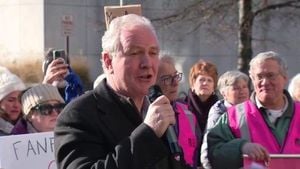On October 7, 2025, the International Energy Agency (IEA) delivered a jolt to the global energy community, announcing a significant downward revision of its forecasts for renewable energy growth. The agency’s latest “Renewables 2025” report, covered by outlets such as ARA, Seeking Alpha, and Euractiv, pinpoints recent policy shifts under the Trump administration as the primary reason for slashing its 2030 U.S. projections by a staggering 50% compared to last year’s analysis. The reverberations from these U.S. policy changes are being felt not only at home but, in a ripple effect, across the world’s burgeoning green energy sector.
According to the IEA’s annual analysis, the United States, once a global driver of renewable energy expansion, is now expected to add nearly 250 gigawatts (GW) of renewable capacity between 2025 and 2030. But here’s the catch: this figure represents a sharp drop from previous expectations, with a peak in new installations forecast for 2027, followed by a decline in 2028 and flatlining growth through the decade’s end. The IEA attributes this dramatic shift to a suite of restrictive policies enacted in Washington over the past year.
So, what changed? The agency’s report singles out legislation passed in July 2025, which brought about the early elimination of critical tax incentives for clean energy, imposed new import restrictions, and led to the suspension and reduction of permits for wind and solar projects on federal lands. The Trump administration’s move to phase out federal tax credits for clean energy installations, halt new offshore wind leases, and clamp down on permitting has, in the IEA’s words, “fundamentally altered the economics and feasibility of renewable energy projects across the United States.”
According to Seeking Alpha, the IEA’s “Renewables 2025” report was unequivocal: “The U.S. is now expected to see its renewable energy growth halved by 2030, on account of the Trump administration’s recent policy changes.” This is no minor adjustment. The United States, which for years has been a bellwether for clean energy innovation and investment, now finds itself on an uncertain path, with the IEA’s forecasts for the country cut by almost 50% compared to last year.
But the United States isn’t the only nation facing new headwinds. The IEA’s analysis also revised downward its projections for China, the world’s leading renewable energy market. The agency points to a policy shift in Beijing—the move from fixed tariffs to competitive auctions for new projects—as a factor “affecting project economics, leading to a reduction in our forecast for renewable energy growth in the Chinese market.” Still, even with this revision, China is expected to add nearly 2,660 GW of renewable capacity over the next five years, maintaining its position as the world’s renewable powerhouse with more than half of global capacity.
Despite these setbacks in the world’s two largest economies, the IEA report offers some reasons for optimism. Growth prospects in India, Europe, and a host of emerging and developing economies have actually been revised upwards. The agency attributes this to “ambitious new policies, increased auction volumes, faster permitting, and a slower rollout,” which together are helping to offset the gloomier outlook in the U.S. and China. In fact, India is projected to emerge as the second largest market in absolute terms, with a projected growth of 345 GW—tripling its capacity by 2030. Europe, too, is set to make a major contribution, expected to add approximately 630 GW, representing a 67% increase in capacity.
The IEA’s findings highlight the growing importance of long-term green power purchase agreements (PPAs) as a driver of global supply. According to the report, PPAs and related mechanisms now account for 30% of the expansion in global renewable capacity through 2030, doubling their share compared to last year’s forecast. This shift reflects a broader trend toward market-based solutions and private sector involvement in the clean energy transition.
Globally, the IEA estimates that renewable energy growth will reach 4,600 GW by 2030—more than doubling current volumes. A remarkable 80% of new renewable energy installations over the next five years are expected to be solar photovoltaic plants. The agency notes that this rapid expansion should lead to lower panel costs and faster permitting times, potentially accelerating the transition to cleaner energy sources. However, not all segments of the renewable sector are faring equally well. The outlook for offshore wind energy, in particular, has become “more uncertain,” with growth expectations down 25% due to changes in key markets and persistent supply chain bottlenecks.
While the rest of the world races to double its green power capacity, the U.S. slowdown stands out as a stark reversal. According to ARA, the early phaseout of federal tax credits, new import restrictions, and the suspension of permits for major projects have all contributed to a more challenging environment for American renewable energy developers. The IEA’s report underscores just how much policy decisions can shape the trajectory of an entire industry—and, by extension, the world’s efforts to combat climate change.
The IEA’s analysis has not gone unnoticed by policymakers and industry leaders. The agency’s warning that “offshore wind energy faces a more uncertain outlook, with growth expectations down 25% due to changes in key markets and supply chain bottlenecks” has sparked concern among clean energy advocates, who argue that stable, supportive policies are essential for maintaining momentum in the sector. Meanwhile, the report’s emphasis on the dynamism of India, Europe, and emerging economies offers a glimmer of hope that global progress on renewables may continue, even if the U.S. stumbles.
In its conclusion, the IEA makes clear that the next few years will be pivotal. The decisions made by governments, investors, and industry players will determine whether the world can stay on track to meet its climate goals—or whether the current slowdown in major markets like the U.S. and China will become a long-term drag on global progress. For now, the message from the IEA is unmistakable: policy matters, and the fate of the world’s clean energy future hangs in the balance.





